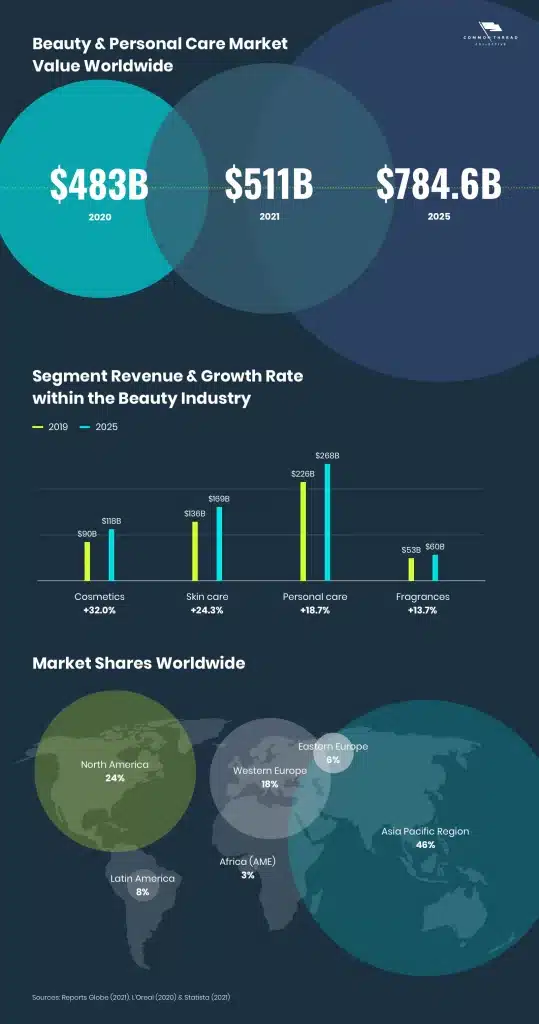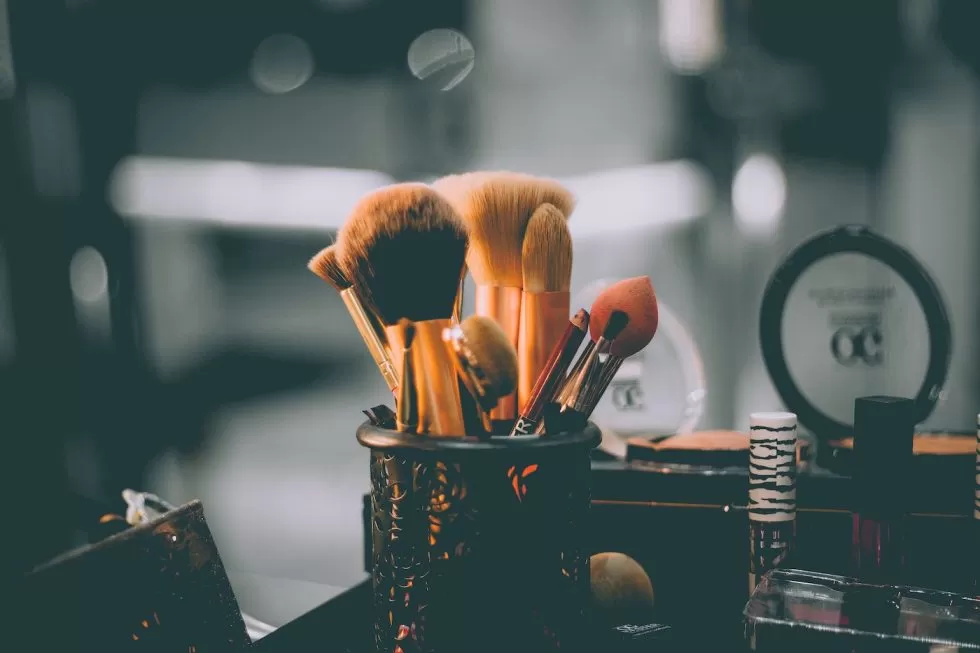Beauty ecommerce marketing driving brand awareness. For Direct-to-Consumer eCommerce brands, visibility isn’t just about building brand awareness, it’s about being highly relevant to your target audience. For example, speaking to each consumer personally as a unique individual as through recommended product selection both in imagery, offer, and tone of voice that aligns across marketing touchpoints.
Speaking of marketing touchpoints, one of the key challenges for emerging beauty brands is to get your traffic mix right.
For example, most DTC eCommerce beauty brands invest heavily in paid social ads to scale initial awareness. It’s easy to see why – the average person spends an hour and 40 minutes per day on social media, and targeting capability based on interests, preferred brands, and shopping behaviour is entirely possible. So for an early-stage DTC eCommerce brand, your traffic mix (based on website sessions) might look something like this:
- Paid Social: 50%
- Paid Search: 20%
- Organic & Direct: 10%
- Email: 10%
- Other: 10%
Although the returns almost directly invert this ranking, nevertheless capturing your audience initially is the priority.
However, as you begin to scale your reliance on certain channels also flexes. Mature DTC brands tend to see a higher proportion of traffic from paid search, email, and organic sources, and comparably less from paid social.
1. Leveraging Paid Social Ads To Reach Consumers
With the ability to target your audience based on interests, preferred brands, shopping behaviour etc., paid social ads can help you to build visibility at an alarming rate.
Facebook remains the largest platform in terms of social ads, so let’s take a brief look at each step within the campaign execution workflow of a Facebook campaign.
Step 1: Objective setting
Understanding what profitable Cost per Acquisition looks like is all-important to scaling paid social as a channel. Understanding customer lifetime value is a useful starting point when considering profitable customer acquisition.
For example, if your Average Order Value is $100 and customers typically purchase 4 times over the course of their relationship with you, then you can assume that your LTV is $400. Assuming that you don’t want to spend more than 25% of the value of a product to acquire a customer, your Cost Per Acquisition target would be $100.
For emerging brands, it’s difficult to set acquisition goals based on customer lifetime value, as you simply won’t have that level of insight. But the basic mechanisms remain the same:
- Take your Average Order Value.
- Work out your desired Cost Of Sale.
- Put the two together: $100 AOV * 25% Cost Of Sale = $25 Cost Per Acquisition target.
Set goals that allow you room to acquire customers at scale. You might also want to adopt specific acquisition cost targets for individual hero products or specific product categories, where you notice that AOV and Conversion Rate may fluctuate significantly from your average.
Step 2: Plan and structure your ad account
Keep the number of ads you have running at a time manageable. With too many ads, you run the risk of eating away your budget, and you won’t be able to scale. The structure works well as a starting point, but you might want to amend based on AOV and Conversion Rate by product category.

Step 3: Get your retargeting journey right
Retargeting is a crucial part of the customer acquisition process. Not only is this important for acquiring new customers, but also key to reactivating existing ones.
At the heart of it, Facebook retargeting success comes down to four core audience segments: website visitors, category page or product page visitors, cart or checkout abandoners, and recent customers.
For best results, we’d recommend automatically syncing your CRM audience to Facebook, as it allows you to always ensure that each individual consumers offerings are fresh and relevant. Manually uploading customer data is an alternative, but far from ideal if you’re dealing with thousands of customers across multiple audiences.
If you’re using an email automation platform like Ometria or Klaviyo, this is pretty straightforward to set up. Within Klaviyo for example, head on over to the “Integrations” tab and connect your account with Facebook to automatically sync over your email segments over to Facebook. (Both companies partner SwiftERM which is often used alongside and in addition to both).
SwiftERM delivers individual personalisation of product selection, using a predictive personalisation algorithm, which selects the products each individual is most likely to buy next. Hardly surprising that McKinsey verified it outperforms all comers.
Step 4: Connect with impactful creative
We’ve talked about targeting, but by far the most crucial part of the equation is your creative. If you’re not relevant with your ad creative, i.e. matching the user’s last interaction they had with you to the next ad that you show them, you’ll quickly lose them and suffer higher click-costs as a result.
Bear in mind the following when crafting your creative:
- Are you infusing user-generated content to reflect that people like them are benefiting from using your products?
- Do you acknowledge specific pain points that the user faces every day?
- Are you backing up your claims with social proof elements that resonate with the user (i.e. awards, press reviews, customer testimonials)?
- Is your offer relevant and attractive to the user?
Lipstick brand ColourPop delivers relevancy here by running an ad about duped colours to audiences that are interested in competitor products. They acknowledge a specific pain point (buying “kiss-proof” lipsticks at a reasonable price), and the engagement on the ad delivers a strong social proof signal to even the most skeptical consumer.
2. Influencer Marketing
Influencers are particularly useful when it comes to beauty and cosmetics marketing, as they have the ability to share results in real-time.
With influencers’ live social media tutorials, consumers can experience the assurance associated with a brick-and-mortar store, where they can try on samples before they commit to purchase.
Choosing which type of influencer to work with
One of the key things to initially think about with influencer marketing is, what kind of influencer will you work with to maximise returns?
There are two types of influencers, micro and macro-influencers. Micro-influencers are those with a following in the range of 1,000 and 100,000 fans and may be experts in one or two specific niches. On the other hand, macro-influencers are those with millions of followers, and who may have a broader set of followers.
While macro-influencers can be attractive with their larger following, micro-influencers have a higher potential when it comes to marketing beauty products. Consumers tend to listen to influencers who represent them demographically and face the same challenges as they do. That’s why a scrappy-looking YouTube video on how to conceal pigment spots featuring a person who actually has them, will likely be more relatable than a macro-influencer with seemingly “perfect skin” mentioning your product in passing.
An example of a brand that leverages micro-influencers well is Suave Beauty.
They worked with a number of African-American beauty influencers in a bid to reach a multicultural audience. With this campaign, they recorded an 11 point lift in brand recall and a 6 point lift in purchase intent.
According to Cody Wittick of Kynship, an influencer marketing agency, YouTube tutorial content that shows the results of a product, plus influencer testimonials such as “this product made me [benefit]” can be effective at achieving cut-through with a particular audience.
Finding influencers to work with
The first step in finding relevant influencers to work with is to consider all of the options. There are usually four main ways to find influencers:
- Analysing influencer followers (people that follow influencers)
- Analysing which influencers your followers follow
- Analysing who your competitors follow
- Influencer marketplaces
Influencer followers
You may find that influencers typically follow and engage with one another as a form of community, meaning you can find other influencers by seeing who the influencer is following and interacting with. Social platforms also do a great job of grouping similar influencers together, and you may see recommendations to follow certain influencers based on other people you follow.
Influencers your followers follow
You can analyse the influencers that your followers follow in order to build an idea as to who is relevant in your space. If you see trends in that the same people are being followed by multiple followers, it’s usually an indication that the influencer is aligned to your target audience.
Analysing who your competitors follow
Analysing your competitors’ activity can yield multiple benefits, not least when it comes to influencer marketing. Take a look at who they follow to unearth insights around the types of influencers they engage with – then approach them to work with your brand. You can also take note of where competitor brands have been tagged across social media platforms in order to find influencer posts. Chances are if they’re relevant to your competitors’ audience, they’ll be relevant to yours too.
Influencer marketplaces
As influencer marketing has gained in popularity, a number of marketplaces have sprung up to help you source influencers. These include Shoutcart, Whala, Socialix and HashtagPaid to name a few.
3. Search Engine Marketing
Search Engine Marketing always was, and will continue to be, one of the most important channels you can use for capturing high-intent demand.
Approximately, two-thirds of SEM clicks on Google go to Google Shopping ads, the image-focused product links at the top or side of text listings.
Within Google Shopping, there are three core elements that will determine the success of your campaigns:
- Data feed management
- Shopping campaign structure
- Bid management
Data feed management
Rock-solid data feed management is a central part of winning with Google Shopping. That’s because as opposed to standard search campaigns, Google Shopping campaigns don’t use keyword targeting to match ads against search queries. Instead, ads are targeted using the data in your product data feed which sits within Google Merchant Center. Ads are created on-the-fly using structured product data.
Google has a long list of specifications that explains which data they need and in which format they need it in.
While there’s plenty of data you can send directly to Google in feed format, not all fields are equal. Certain optimisations will have more of an impact than others, with product title perhaps being the most important.
As you only have a limited amount of characters to play with before text gets truncated, it’s important that you align product titles with how users are searching for specific products or product types. Examples may include:
- Brand + Product Type + Colour + Material
- Gender + Brand + Size + Product Type + Colour
- Material + Product Type + Colour + Brand
- Style + Colour + Product Type + Brand
Think about how you can get potential non-brand search keywords into your products. And take note of the order. Google places more weight on words at the beginning of the title than those towards the end.
Campaign structure
In general, we’d recommend setting up multiple Shopping campaigns, based on different Return on Ad Spend goals. At the top tier, focus on your best-performing products within a Smart Shopping campaign. This will ensure that your top-sellers receive the lion’s share of your overall budget.
In your secondary campaign, you’d want a lower budget for products that deliver middle-of-the-road Return on Ad Spend, perhaps due to lower AOV or Conversion Rate.
Bidding strategy
Google Smart Shopping employs smart bidding for it to determine how much to bid across each impression. Basically, this means looking at hundreds of data signals to determine how much each impression is worth – for example, if the user has been on your website previously, if they fit into a relevant “in-market” Google audience segment, and the device that they are using.
Setting a Return on Ad Spend goal that’s not realistic based on historical data trends can result in poor campaign performance, so it’s important to ensure that the goal that you apply is realistic. Our best practice here is to aim between 120% and 140% of your historical average.
It’s also important to allow the bid strategy at least 15 days to run before you make further changes, as it kick-starts a ‘learning phase’. If, after a period, you make significant changes to your campaign, like restructuring your product groups or changing the target products, give the bid strategy time to adjust.




